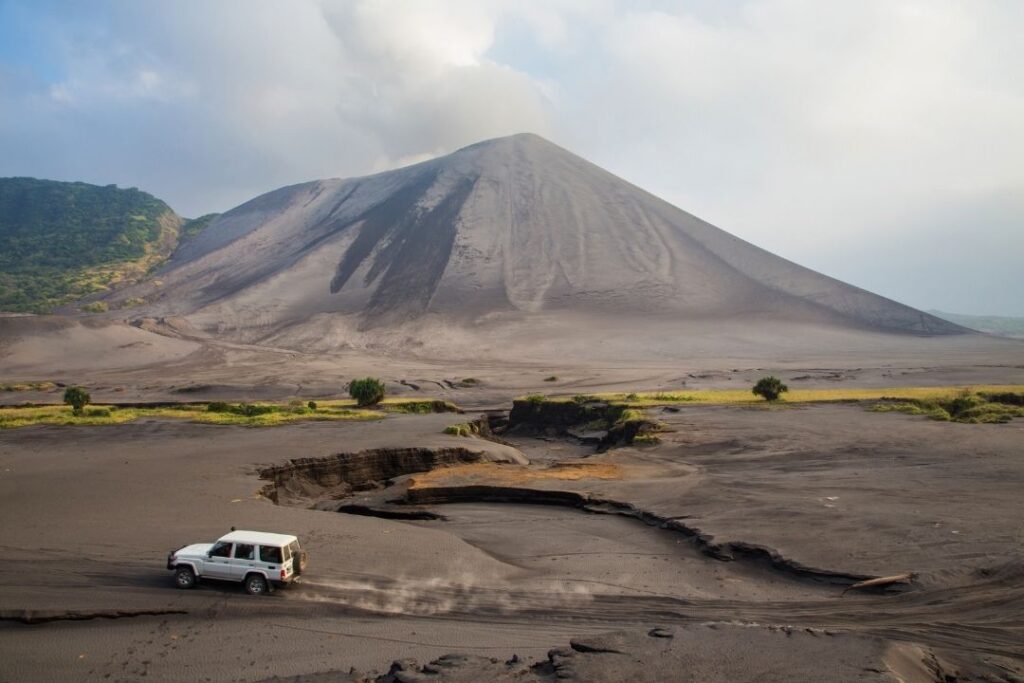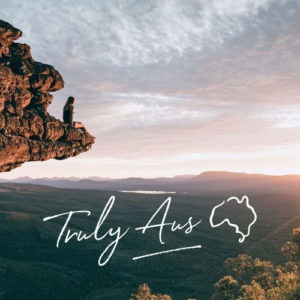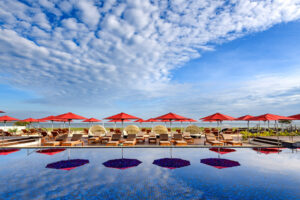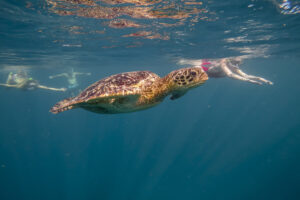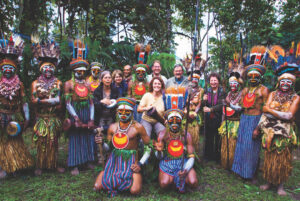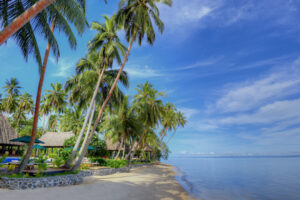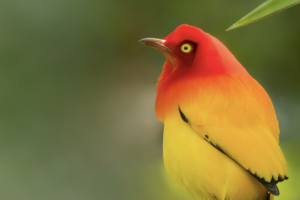The island of Tanna is one of the most peaceful, underdeveloped islands in the Pacific. Here, time really has stood still.
A brigade of boisterous boys bursts out of the door-sized clearing in the thick wall of jungle like a flock of noisy miners: a tangle of skinny, dark-skinned legs and arms flapping about in wild excitement.
As they move towards me in a jostling clump of nakedness, their toothy smiles flash out from faces framed by clipped Afros. They are confident and outwardly curious – they’ve seen many a foreigner before but I’m still a novelty and they reach forward to touch my white skin and auburn hair. They gather around the guide’s 4WD that we tackled the flooded mountain road in, chattering away as they concoct a cheeky plan. Then they’re all laughing and lining up behind the car – bottoms poking out and skinny legs in a row of gangly right angles – attempting to push it with all their might. It’s not going anywhere but they think it’s hilarious.
As the boys start to dance around the vehicle in the middle of the mud road (we’re probably the only ones driving up here today so there’s no need to shoo them to roadside safety) a large busty woman in her 50s, dressed in thick layers of flowing dried pampas grass appears in the jungle parting. She fills the space, not just in figure but also in presence. The boys understand her importance – and we can see that they also feel her love for them – so they quieten down, still grinning from ear to ear.
They’re standing tall and proud – as if they found me for her.
The village of Lowinio
The woman steps forward, leafy layers rustling. “Welcome to our village – Lowinio,” she says softly. “My name is Annie. Please, come.” She waves her hand towards the jungle parting and slips back in with a few swishes of her wide hips. We follow her and on the other side of the wall, a welcome coolness settles upon me as we leave behind the summer sun’s intense heat and the day’s humidity. We’re now in a deep jungle clearing, walking on black soil trodden so firmly it’s like river pebbles underfoot, with thick canopies of woven jungle palm leaves above. Annie gestures at some logs and I sit, just as the stream of giggling boys slips by.
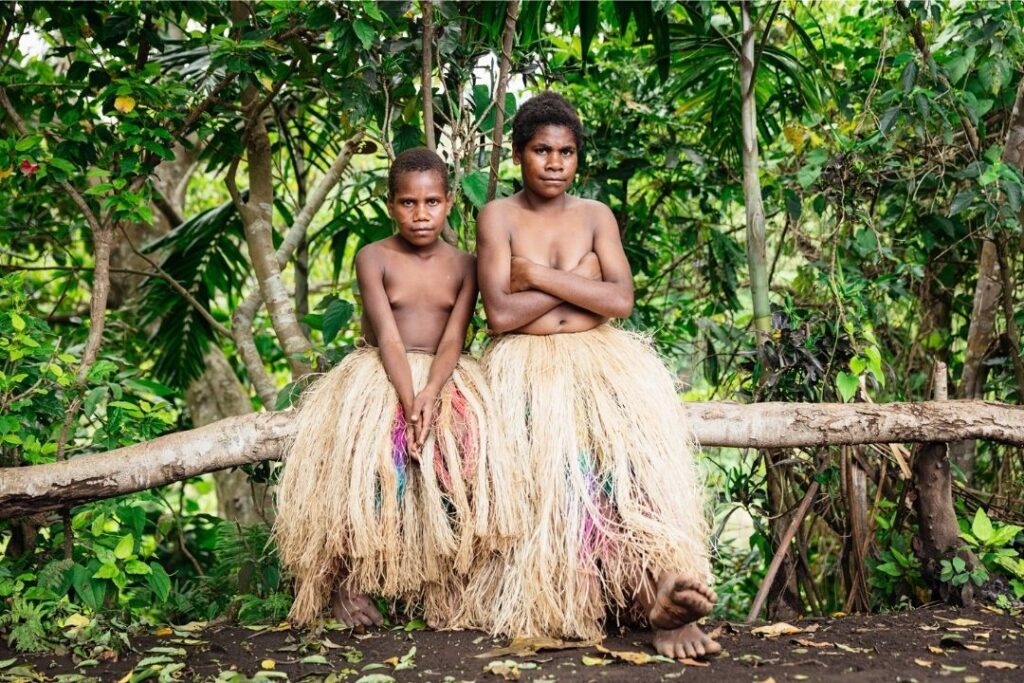
I sit in silence as Annie, who I learn is the Chief’s wife and mother of eight children, tells us about Lowinio. The village is also known as Lagalangia Kustom Village due to its traditional preserved state and the cultural tours for visitors to Tanna that Annie runs. She apologises for her husband’s absence and explains that he is away for the day, hoping to help settle a dispute in a neighbouring village.
In Annie’s village, food and herbs are grown on the land with no pesticides and meals are cooked in traditional earth ovens. Food staples are yam, taro, banana, coconut, sugarcane, tropical nuts, greens, pigs, fowl and seafood.

Clothes, penis gourds, bags, jewellery, furniture, houses, and weapons for killing and preparing animals are all made from the abundance of surrounding plants, trees and stone and, really, that’s all the villagers need – food, shelter and basic clothing. Although, Annie concedes with a motherly smile that her pretty teenage girls love their grass skirts coloured in rainbow stripes with vegetable dyes, and that these little luxuries mean more goods have to be bartered.
Tradition lives on
Boys are circumcised by the men with sharpened bamboo – it sometimes leads to infected wounds and death but it’s a custom that is as ingrained in society as dancing rituals. Young girls’ backs are inscribed upon when they have had their first period – a clear sign that they have reached womanhood – with multiple incisions in their skin also made with bamboo. Botanical medicine is the norm, but if a villager is really sick, they’re taken to the one hospital on the island where there is a Canadian doctor. “Sometimes the men leave that decision for too long. If they don’t think a person is sick enough for us to find money to send them to the hospital, then they can die waiting,” says Annie sadly, explaining that their women sometimes die in childbirth. “We need more education here on health and medicine,” she admits.
The men wear little other than penis gourds made from the dried pampas grass, with a thick gathering of strands hanging below their genitals like a horse mane. Some of the men also wear jewellery made of leather and shells.
Life has remained largely unchanged for centuries for the villagers of Tanna, living high up in the mountains where mangoes are wild and plentiful and pigs are still bartered for wives. Couplings are decided upon by elders, and young wives always move away from their villages to live with their husbands’ people. Land is always handed down to the men in any family, and income is shared by one and all. It’s an age-old tribal existence and one that will probably not change for many decades to come, as the people are so remote and disconnected from Western culture.
The past and the future
Signs of change have, however, found their way through the thick jungle: Annie tells us that she has put one of her daughters through school and that she now has a job on the radio in Port Vila on the main island of Efate, as a radio DJ. She is fluent in French and will come back soon to work alongside Annie on the ‘kustom’ village tours, created to bring money into the village. Most of this money is used on schooling, as it costs around AU$250/NZ$260 for children in Vanuatu to attend school.
After two of Annie’s daughters make me a delicious meal – banana with coconut oil, cabbage and bush herbs ground into patties and cooked in palm leaves in an earth oven – the men and women put on a concert. Dance is incredibly important to the people of Tanna, and they revel in it. For centuries, dance has been a means of telling stories in Vanuatu, and it brings the people together for celebrations – for everything from birth to death or a great crop. Some villages have dancing grounds called Nasara, and many people from Vanuatu believe wealth can be attained through their ceremonies. Every year, Tanna hosts a traditional event called the Toka Festival, which symbolises an alliance and friendships between different indigenous groups of the region.
Beautiful offerings
Mid-dance, rain begins to fall heavily so I sit on a bench under a thatched roof, to the side of the Nasara on the edge of the jungle. The chanting and dancing could well be a spectacle from 500 years ago – none of the dancers bear anything to suggest that they have had any contact with the developed world. It’s a mesmerising display that is even more enchanting with the sound of heavy rain on thick foliage. Afterward, as I applaud the beaming villagers, they form a queue then come to me one by one – the men shaking my hand and the women gently planting kisses on my cheeks.
We depart the village and head down the road to where I’ve been told a village choir would like to sing for me. Something people new to Vanuatu will notice is that locals often have English names and they also sing in English. I’ve realised this is the result of a strong belief by most people in Christianity, and it playing a large role in society. So most people have an English name as well as a traditional name and, as a visitor, you’ll almost always hear the English name first. Early English missionaries arrived in Vanuatu in 1839, but they didn’t last long, unfortunately becoming the first missionary victims of cannibalism. But that didn’t deter the next wave of missionaries, and by the 1860s there were various denominational mission stations throughout Vanuatu’s islands.
On Tanna, most of the villagers believe in God, so my leaving song is about uniting as a family, taking care of one another and being good in the eyes of God. It’s also, on a more simple level, a touching display of how the villagers, with nothing to give of monetary value, are so eager to give something beautiful.
Everyone in the choir has spent the morning picking flowers from the jungle and wrapping them with leaves to form heartfelt bouquets. The man leading the choir steps up to me when the singing is finished and says: “We have nothing to give you, so we give you flowers and song.” Everyone smiles and waves to us as we go, the children and adults all so proud of their efforts. We go on our way – I even more in love with the people of Tanna. The realisation is creeping in as well: not a single person has tried to sell me anything in Vanuatu – extracting money from others does not cross their minds.

Before heading to the main tourist drawcard on Tanna, the continually erupting volcano that is Mount Yasur, I stop by the weekly Lenakel food markets which are positioned on a small harbour where the main staple purchased by islanders comes in – Australia’s SunRice. Everything else at the markets is fresh produce carted around in bags woven from plants, laid out on the ground in all of its natural glory. Perhaps that’s why the people of Tanna look so healthy – their lives are based on simple fresh food. Piles of vegetables and fruit, enormous bunches of herbs and clumps of peanuts with their stems still attached sprawl in all directions. The size of the cucumbers and zucchinis are gobsmacking, and the pure, delicious taste of everything grown on Tanna must have something to do with local farmers not using any chemicals (most can’t afford it even if they wanted to) and also the abundance of volcanic soil. That special mineral-rich soil leads me to one of the things I have come to see – how Tanna came to be pushed out of the ocean and into existence by the sheer force of Mother Nature and her volcanic movements. What better way to do that, than by visiting Mount Yasur, which is thought to have been in eruption mode for over 800 years, and certainly since Captain Cook first saw it shooting off sparks and ash back in 1774.
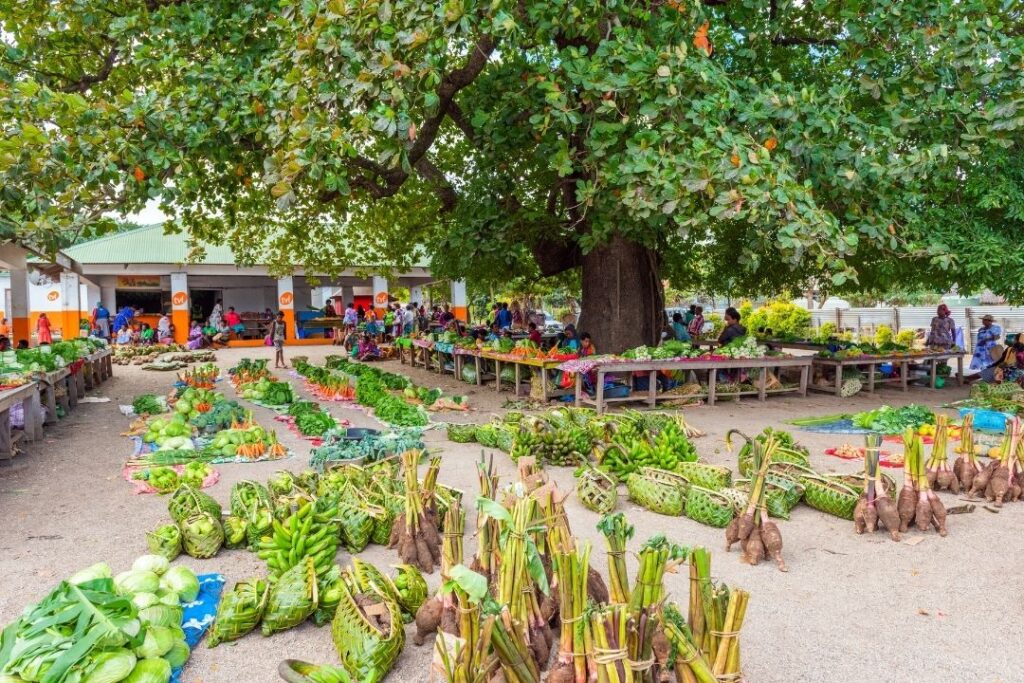
There are only a handful of places in the world where you can experience something like Mount Yasur, and it’s hard to put into words how moving it is to see the hot innards of the Earth in action. The drive across acres of ash plains to reach it is like no other journey: you cruise across a desert of pale grey ash as smooth and soft as icing sugar, with Yasur and her smoke dominating the landscape. The surreal experience is followed by an ascent through thick jungle to a plateau where you come to more barren ash fields – this time marred by a staircase winding up one side of the volcano. It’s there that you begin to hear and feel the rumbling.
The acid ash that Mount Yasur spews out is a problem for locals – it’s as light as dust and makes its way into every crevice of homes and into the air filters of cars. But the volcano is sacred – with Yasur in local language meaning God. It is said that some of Tanna’s tribes believe God lives within the crater.
There are no fences, guards on duty or signs at the summit. It’s just you and some others on the side of a live volcano – lava burbling below, fire and earth regularly spitting, spiralling and cascading through the air. When night falls, sitting on the rim before Yasur’s steamy display is more spellbinding than any fireworks display you’ll have ever seen. You just won’t want to leave.
Thanks to its multi-cultural Melanesian, French, Spanish, Polynesian, and Asian heritage, Vanuatu is a foodie paradise. Find out why here.

